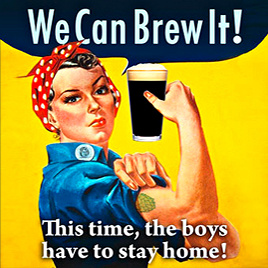
What do we brew beer with?
With hops? No, the raw material of beer is starch. Where do we get it? Humans have brewed their beer with all the starch-rich plants they had on hand: barley and wheat of course, but also rice, millet, sorghum, maize, manioc, sago, carob, taro, yam, and many other plants ...
The ancient peoples of India drank only milk or a sacred beverage called Soma.
A romantic or new-age portrayal of an ancient India unaware of almost any fermented beverage, but not of cannabis! The Vedic texts offer a different picture. Already around 1500 BC, a beer called surā was both a daily and a sacred beverage. Brahmanism, Buddhism or Jainism have not profoundly affected these customs. Few people know that the Indian subcontinent is also a very old brewing area.
Was beer invented to intoxicate our ancestors?
Most likely, though unverifiable. Only genetics and observation of higher primates can tell us. Humans inherited, along with their primate cousins, an ability to metabolize ethanol. Not all animal species do. Moreover, their environment was brimming with fruits, grains and honey. All were part of their seasonal and omnivorous diets. Beer is derived from a common core of hybrid fermented beverages. They were at the same time beer, mead and wine since they were brewed with a mix of crushed (chewed?) grains, roots, fruits, honey and herbs. Beer was truly born when human groups specialised their food sources, their subsistence techniques and their cooking, becoming farmers or horticulturists, or herders while others chose to stay hunters and foragers ...
The beer is brewed with hops.
Hops, it's the brewer's vine. A poetic but false imagery. Hops are not the basic ingredient of modern or ancient beers. This aromatic plant was only introduced in brewing around the 9th century in Europe. Before the hops, brewers used other aromatic plants, some with antiseptic properties. Hops bring bitterness and antiseptic substances. Starch is the fundamental ingredient. ...
Evolution of beer in the world through the ages
What you can read on blogs or in popularisations: 1 - brewing techniques have not evolved much since the prehistory of beer. Beer is still a kind of elementary cooking. Anyone can brew beer in his courtyard or kitchen. We can safely recreate the beer of the Egyptians, Sumerians or ancient Chinese. 2 - Beer underwent a metamorphosis in the 19th century with the invention of industrial beer, the healthy, filtered, fizzy, frothy beer we have been drinking ever since. Before, beer looked like a sour fermented mush that was barely drinkable, a mixture that nobody would dare to drink nowadays! Who is right? Neither the first nor the last. These over simplifications do not do justice to the history of beer. Beer history is richer, more complex and more fascinating. Starting with the brewing methods. There is not just one technique, but six in all. And all of them have their own history since the very beginning of beer ...
Beer is brewed only with barley malt, hops and water. Not so sure !
Humans brewed their beer with all the starch-rich plants they had on hand. Cereals of course (barley, wheat, rye, rice, millet, sorghum, maize, etc.), grasses (quinoa, job tears, etc.), tubers (cassava, taro, yam, sweet potato, potato, etc.), starchy fruits (plantain, carob, breadfruit, etc.), the pith of certain trees (sago, etc.), etc.
How long have we been brewing beer?
Beer is the oldest fermented beverage in the world. Its prehistory begins 13,000 years ago in the Near East, in what will become the Fertile Crescent ...
Is beer healthier than water?
Yes, historically for human societies living clustered in the earliest cities. When excavating ancient urban sites, archaeologists discover sewage pipes and drainage systems. Where there were human concentrations and cohabitation with animals, the quality of drinking water was poor. Beer was comparatively healthy.The cooking of the wort (an optional step depending on the technical drawing or the type of beer) and the fermentation ensured a certain hygiene and a barrier against dangerous microorganisms ...
North American Indians brew beer before the coming of Europeans
Hopi, Zuni, Pueblo, Natchez, Sioux, Apache, Creek, Cherokee, Huron, Iroquois ... brewed corn beers several centuries before the coming of the Europeans. In the Southwest (California, Nevada, Arizona) before the first Spanish explorations (1527-1528), along the Mississippi (Cahokia), in the East (Appalachia), and in the Great Lakes region before the French colonization.
Are craft breweries inventing the beers of the future?
The beers in the future (2140-2150) will come from European, African, Asian or American craft breweries. But which kinds of beer? Fruit beers, gruit beers, sour beers, IPAs, wild beers... Not really new. All these "styles" listed in the USA replicate beers that have already existed. These "styles" never deviate from the traditional European pattern: malting and brewing in liquid phase (beer wort). How innovative are these craft beers? As long as they are trapped in the history and methods of Western brewing, they will taste, smell and colour the same.
How is beer brewed?
You think there's only one way to brew beer? There are 6 different technical methods to make it. The best known in westerner countries is malting based on the germination of cereal grains to make malt. The most widespread in the world is the Asian method. For thousands of years it has used the ability of certain fungi to hydrolyse starch and convert it into sugars that yeasts or these same fungi convert into alcohol. This is how Japanese sake, Chinese jiu, Korean makgeolli and many other kinds of tradtional beers are brewed in Asia. The oldest method, still used in certain world areas, uses saliva and its amylase (ptyalin) to convert starch into fermentable sugars. Another method, this time from Africa, finds the starch hydrolysis powers in certain roots. The 5th method takes the acid pathway. A sour infusion will equally hydrolyse the starch. The 6th method works by over-ripening starch-rich fruits such as plantains ...
The craft brewery revolution was born in Great Britain
The craft beer revolution began in the UK in the early 1970s. Professional brewers, beer lovers and publicans founded the Campaign for Real Ale (CAMRA) in 1971 to defend traditional ale against the invasive, bland continental lager. This powerful movement began to make its mark. Craft breweries began to spring up in Britain and then on the European continent. 20 years later, the movement crossed the Atlantic. Canadian and American enthusiasts, who came to Europe to train, set up their first craft breweries in the 1990s. Why do people wrongly say or write that the craft beer revolution was born in the United States?
In ancient times, beer could not be stored.
Beer had to be drunk within 2 to 3 days after brewing. This is true of western, African or Amerindian beers brewed by fermentation of a wort, a liquid medium so, with or without cooking. As soon as the temperature is around 20-30°C, the beer will slowly but surely acidify. This is not true of Asian beers as long as the barely moist mass of fermented grains is not mixed with water and remains enclosed in a jar. ...
Did women brew beer before men made it?
A common misconception. In ancient times, in Mesopotamia and Egypt, which are often cited as examples, men and women worked in brewing workshops. The cuneiform tablets bear witness to this, as do the Egyptian funerary wooden models. There were many tasks in a brewing workshop: germinating the grains, grinding them, crushing the malt, kneading the dough, heating the pots, filtering, monitoring fermentation, filling the jars, etc. Women and men worked in teams for the great institutions of the time (palaces, temples, royal burial sites). There was also a domestic brewery and another for the beer trade (inn, tavern). In Mesopotamia, women owned some of these tavern-inns. But there is no evidence that they brewed beer themselves. In these slave-based societies, the actual work was done by male and female slaves. Brewing and selling beer was no exception to this rule. It was not a particularly female activity. The idea that beer was a female affair was too quickly drawn from myths and the gender of deities (Ninkasi, Ishtar, Sekhmet), confusing social reality with symbolic representation. Regarding the European Middle Ages, the sharing of tasks between men and women also existed...


